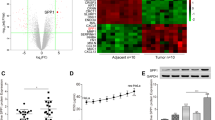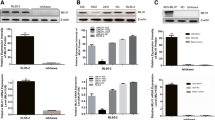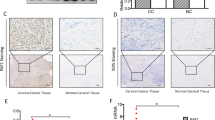Abstract
Cisplatin (DDP) is widely used in the chemotherapy of cervical cancer (CC), the fourth most common female malignancy worldwide. However, some patients progress to chemotherapy resistance, which leads to chemotherapy failure, tumor recurrence, and poor prognosis. Therefore, strategies to identify the regulatory mechanisms underlying CC development and increase tumor sensitivity to DDP will help improve patient survival. This research was designed to ascertain the mechanism of EBF1-dependent regulation of FBN1 which promotes chemosensitivity of CC cells. The expression of EBF1 and FBN1 was measured in CC tissues resistant or sensitive to chemotherapy and in DDP-sensitive or -resistant cells (SiHa and SiHa-DDP cells). SiHa-DDP cells were transduced with lentiviruses encoding EBF1 or FBN1 to evaluate the influence of these two proteins on cell viability, expression of MDR1 and MRP1, and cell aggressiveness. Moreover, the interaction between EBF1 and FBN1 was predicted and demonstrated. Finally, to further verify the EBF1/FB1-dependent mechanism of DDP sensitivity regulation in CC cells a xenograft mouse model of CC was established using SiHa-DDP cells transduced with lentiviruses carrying EBF1 gene and shRNA directed to FBN1·EBF1 and FBN1 showed decreased expression in CC tissues and cells, particularly in those resistant to chemotherapy. Transduction of SiHa-DDP cells with lentiviruses encoding EBF1 or FBN1 lead to decreased viability, IC50, proliferation capacity, colony formation ability, aggressiveness, and increased cell apoptosis. We have shown that EBF1 activates FBN1 transcription by binding to FBN1 promoter region. Additionally, it was revealed that FBN1 silencing reversed the promoting effect of EBF1 overexpression on chemosensitivity of CC cells in vivo. EBF1 facilitated chemosensitivity in CC cells by activating FBN1 transcription.






Similar content being viewed by others
REFERENCES
Vu M., Yu J., Awolude O.A., Chuang L. 2018. Cervical cancer worldwide. Curr. Probl. Cancer. 42 (5), 457—465.
Arbyn M., Weiderpass E., Bruni L., de Sanjosé S., Saraiya M., Ferlay J., Bray F. 2020. Estimates of incidence and mortality of cervical cancer in 2018: A worldwide analysis. Lancet Glob. Health. 8 (2), e191—e203.
Ryan M., Marlow L., Waller J. 2019. Socio-demographic correlates of cervical cancer risk factor knowledge among screening non-participants in Great Britain. Prev. Med. 125, 1–4.
Small W., Jr., Bacon M.A., Bajaj A., Chuang L.T., Fisher B.J., Harkenrider M.M., Jhingran A., Kitchener H.C., Mileshkin L.R., Viswanathan A.N., Gaffney D.K. 2017. Cervical cancer: A global health crisis. Cancer. 123 (13), 2404—2412.
Pfaendler K.S., Tewari K.S. 2016. Changing paradigms in the systemic treatment of advanced cervical cancer. Am. J. Obstet. Gynecol. 214 (1), 22—30.
Zhu H., Luo H., Zhang W., Shen Z., Hu X., Zhu X. 2016. Molecular mechanisms of cisplatin resistance in cervical cancer. Drug. Des. Devel. Ther. 10, 1885—1895.
Nieminen-Pihala V., Tarkkonen K., Laine J., Rummukainen P., Saastamoinen L., Nagano K., Baron R., Kiviranta R. 2021. Early B-cell Factor1 (Ebf1) promotes early osteoblast differentiation but suppresses osteoblast function. Bone. 146, 115884.
Armartmuntree N., Murata M., Techasen A., Yongvanit P., Loilome W., Namwat N., Pairojkul C., Sakonsinsiri C., Pinlaor S., Thanan R. 2018. Prolonged oxidative stress down-regulates Early B cell factor 1 with inhibition of its tumor suppressive function against cholangiocarcinoma genesis. Redox Biol. 14, 637—644.
Xing M., Ooi W.F., Tan J., Qamra A., Lee P.H., Li Z., Xu C., Padmanabhan N., Lim J.Q., Guo Y.A., Yao X., Amit M., Ng L.M., Sheng T., Wang J., Huang K.K., Anene-Nzelu C.G., Ho S.W.T., Ray M., Ma L., Fazzi G., Lim K.J., Wijaya G.C., Zhang S., Nandi T., Yan T., Chang M.M., Das K., Isa Z.F.A., Wu J., Poon P.S.Y., Lam Y.N., Lin J.S., Tay S.T., Lee M.H., Tan A.L.K., Ong X., White K., Rozen S.G., Beer M., Foo R.S.Y., Grabsch H.I., Skanderup A.J., Li S., Teh B.T., Tan P. 2020. Genomic and epigenomic EBF1 alterations modulate TERT expression in gastric cancer. J. Clin. Invest. 30 (6), 3005—3020.
Zhu J., Wang H., Ma T., He Y., Shen M., Song W., Wang J.J., Shi J.P., Wu M.Y., Liu C., Wang W.J., Huang Y.Q. 2020. Identification of immune-related genes as prognostic factors in bladder cancer. Sci Rep. 10 (1), 19695.
Shen Z., Chen Y., Li L., Liu L., Peng M., Chen X., Wu X., Sferra T.J., Wu M., Lin X., Cheng Y., Chu J., Shen A., Peng J. 2020. Transcription factor EBF1 over-expression suppresses tumor growth in vivo and in vitro via modulation of the PNO1/p53 pathway in colorectal cancer. Front. Oncol. 10, 1035.
Ribera J., Morgades M., Zamora L., Montesinos P., Gómez-Seguí I., Pratcorona M., Sarrà J., Guàrdia R., Nomdedeu J., Tormo M., Martínez-Lopez J., Hernández-Rivas J.M., González-Campos J., Barba P., Escoda L., Genescà E., Solé F., Millá F., Feliu E., Ribera J.M.; Spanish PETHEMA Group and the Spanish Society of Hematology (2015) Prognostic significance of copy number alterations in adolescent and adult patients with precursor B acute lymphoblastic leukemia enrolled in PETHEMA protocols. Cancer. 121 (21), 3809—3817.
Del Cid J.S., Reed N.I., Molnar K., Liu S., Dang B., Jensen S.A., DeGrado W., Handford P.A., Sheppard D., Sundaram A.B. 2019. A disease-associated mutation in fibrillin-1 differentially regulates integrin-mediated cell adhesion. J. Biol. Chem. 294 (48), 18232—18243.
Zhai X., Xue Q., Liu Q., Guo Y., Chen Z. 2017. Colon cancer recurrence-associated genes revealed by WGCNA coexpression network analysis. Mol. Med. Rep. 16 (5), 6499—6505.
Zhang W., Ota T., Shridhar V., Chien J., Wu B., Kuang R. 2013. Network-based survival analysis reveals subnetwork signatures for predicting outcomes of ovarian cancer treatment. PLoS Comput. Biol. 9 (3), e1002975.
Millstein J., Budden T., Goode E.L., Anglesio M.S., Talhouk A., Intermaggio M.P., Leong H.S., Chen S., Elatre W., Gilks B., Nazeran T., Volchek M., Bentley R.C., Wang C., Chiu D.S., Kommoss S., Leung S.C.Y., Senz J., Lum A., Chow V., Sudderuddin H., Mackenzie R., George J.; AOCS Group, Fereday S., Hendley J., Traficante N., Steed H., Koziak J.M., Köbel M., McNeish I.A., Goranova T., Ennis D., Macintyre G., Silva De Silva D., Ramón Y., Cajal T., García-Donas J., Hernando Polo S., Rodriguez G.C., Cushing-Haugen K.L., Harris H.R., Greene C.S., Zelaya R.A., Behrens S., Fortner R.T., Sinn P., Herpel E., Lester J., Lubiński J., Oszurek O., Tołoczko A., Cybulski C., Menkiszak J., Pearce C.L., Pike M.C., Tseng C., Alsop J., Rhenius V., Song H., Jimenez-Linan M., Piskorz A.M., Gentry-Maharaj A., Karpinskyj C., Widschwendter M., Singh N., Kennedy C.J., Sharma R., Harnett P.R., Gao B., Johnatty S.E., Sayer R., Boros J., Winham S.J, Keeney G.L., Kaufmann S.H., Larson M.C., Luk H., Hernandez B.Y., Thompson P.J., Wilkens L.R., Carney M.E., Trabert B., Lissowska J., Brinton L., Sherman M.E., Bodelon C., Hinsley S., Lewsley L.A., Glasspool R., Banerjee S.N., Stronach E.A., Haluska P., Ray-Coquard I., Mahner S., Winterhoff B., Slamon D., Levine D.A., Kelemen L.E., Benitez J., Chang-Claude J., Gronwald J., Wu A.H., Menon U., Goodman M.T., Schildkraut J.M., Wentzensen N., Brown R., Berchuck A., Chenevix-Trench G., deFazio A., Gayther S.A., García M.J., Henderson M.J., Rossing M.A., Beeghly-Fadiel A., Fasching P.A., Orsulic S., Karlan B.Y., Konecny G.E., Huntsman D.G., Bowtell D.D., Brenton J.D., Doherty J.A., Pharoah P.D.P., Ramus S.J. 2020. Prognostic gene expression signature for high-grade serous ovarian cancer. Ann. Oncol. 31 (9), 1240—1250.
Castro-Mondragon J.A., Riudavets-Puig R., Rauluseviciute I., Lemma R.B., Turchi L., Blanc-Mathieu R., Lucas J. Boddie P., Khan A., Manosalva Pérez N., Fornes O., Leung T.Y., Aguirre A., Hammal F., Schmelter D., Baranasic D., Ballester B., Sandelin A., Lenhard B., Vandepoele K., Wasserman W.W., Parcy F., Mathelier A. 2022. JASPAR 2022: The 9th release of the open-access database of transcription factor binding profiles. Nucleic Acids Res. 2022, D165—D173.
Saei Ghare Naz M., Kariman N., Ebadi A., Ozgoli G., Ghasemi V., Rashidi Fakari F. 2018. Educational interventions for cervical cancer screening behavior of women: A systematic review. Asian Pac. J. Cancer Prev. 19 (4), 875—884.
Webb K., Prakash V., Kirresh O., Stewart A. 2018. A case of aortitis during cisplatin-based chemotherapy for cervical cancer. BJR Case Rep. 5 (1), 20180054.
Li R., Song Y., Chen X., Chu M., Wang Z.-W., Zhu X. 2021. METTL3 increases cisplatin chemosensitivity of cervical cancer cells via downregulation of the activity of RAGE. Mol. Ther. Oncolytics. 22, 245—255.
Bullerwell C.E., Robichaud P.P., Deprez P.M.L., Joy A.P., Wajnberg G., D’Souza D., Chacko S., Fournier S., Crapoulet N., Barnett D.A., Lewis S.M., Ouellette R.J. 2021. EBF1 drives hallmark B cell gene expression by enabling the interaction of PAX5 with the MLL H3K4 methyltransferase complex. Sci. Rep. 11 (1), 1537.
Harder L., Eschenburg G., Zech A., Kriebitzsch N., Otto B., Streichert T., Behlich A.S., Dierck K., Klingler B., Hansen A., Stanulla M., Zimmermann M., Kremmer E., Stocking C., Horstmann M.A. 2013. Aberrant ZNF423 impedes B cell differentiation and is linked to adverse outcome of ETV6-RUNX1 negative B precursor acute lymphoblastic leukemia. J. Exp. Med. 210 (11), 2289—2304.
Xu X., Huang A., Cui X., Han K., Hou X., Wang Q., Cui L., Yang Y. 2019. Ubiquitin specific peptidase 5 regulates colorectal cancer cell growth by stabilizing Tu translation elongation factor. Theranostics. 9 (14), 4208—4220.
Mo X., Su Z., Yang B., Zeng Z., Lei S., Qiao H. 2020. Identification of key genes involved in the development and progression of early-onset colorectal cancer by co-expression network analysis. Oncol. Lett. 19 (1), 177—186.
Wang Z., Tu L., Chen M., Tong S. 2021. Identification of a tumor microenvironment-related seven-gene signature for predicting prognosis in bladder cancer. BMC Cancer. 21 (1), 692.
Che X., Jian F., Wang Y., Zhang J., Shen J., Cheng Q., Wang X., Jia N., Feng W. 2020. FBXO2 Promotes proliferation of endometrial cancer by ubiquitin-mediated degradation of FBN1 in the regulation of the cell cycle and the autophagy pathway. Front. Cell Dev. Biol. 8, 843.
Yang D., Zhao D., Chen X. 2017. MiR-133b inhibits proliferation and invasion of gastric cancer cells by up-regulating FBN1 expression. Cancer Biomark. 19 (4), 425—436.
Wang Z., Liu Y., Lu L., Yang L., Yin S., Wang Y., Qi Z., Meng J., Zang R., Yang G. 2015. Fibrillin-1, induced by Aurora-A but inhibited by BRCA2, promotes ovarian cancer metastasis. Oncotarget. 6 (9), 6670—6683.
Wang Z., Chen W., Zuo L., Xu M., Wu Y., Huang J., Zhang X., Li Y., Wang J., Chen J., Wang H., Sun H. 2022. The Fibrillin-1/VEGFR2/STAT2 signaling axis promotes chemoresistance via modulating glycolysis and angiogenesis in ovarian cancer organoids and cells. Cancer Commun. (London). 42 (3), 245—265.
Funding
Not applicable.
Author information
Authors and Affiliations
Corresponding author
Ethics declarations
ADDITIONAL INFORMATION
The text was submitted by the author(s) in English.
COMPLIANCE WITH ETHICAL STANDARDS
Conflict of interest. The authors declare that they have no conflicts of interest.
Statement of compliance with standards of research involving humans as subjects. This study was approved by the Ethics Committee of First Affiliated Hospital of Gannan Medical University and fully complied with the Declaration of Helsinki. All patients had signed written informed consent.
Rights and permissions
About this article
Cite this article
Shen, N.N., Lin, J.H. & Liu, P.P. EBF1 Promotes the Sensitivity of Cervical Cancer Cells to Cisplatin via Activating FBN1 Transcription. Mol Biol 57, 491–501 (2023). https://doi.org/10.1134/S0026893323030093
Received:
Revised:
Accepted:
Published:
Issue Date:
DOI: https://doi.org/10.1134/S0026893323030093




